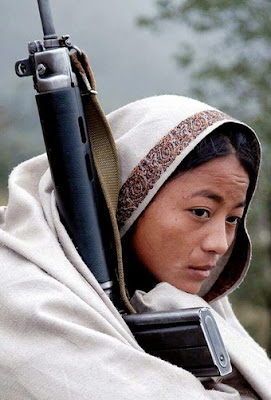 by Derek Rosin – BASICS #14 (June / July 2009)
by Derek Rosin – BASICS #14 (June / July 2009)
Back in 2000, Nepali Maoist leader Prachanda was blunt when talking about the future of the growing revolutionary movement in his country: “Ultimately, we will have to fight with the Indian army.” Prachanda said this when he was an underground revolutionary leading a guerilla war and was speaking of Nepal as a base area for the world revolution. He was rightfully concerned that India would not accept a new, revolutionary state on their northern border and would try to crush it by force if necessary.
Today, as the Nepali Maoists maneuver against the Nepali ruling classes in a complicated legal-political process, they have moderated some of their public proclamations, but there is little reason to suggest that their ultimate goal of being part of a growing world revolution has changed. Enemies of revolution in South Asia have not forgotten this either.
An ominous sign of this threat came in early June when Indian troops encroached on Nepali land in the Terai region near Dang. Reports from Nepal are that the Indian troops committed atrocities that spurred 6000 villagers to flee the area. This is a serious development.
India is no stranger to such intrigues. They provoked war with China in 1962 in an attempt to destabilize the then-revolutionary communist country. In 1987 they sent troops to fight the LTTE in Sri Lanka before being forced out in 1990 after a series of embarrassing defeats against guerilla fighters in rugged terrain.
A full-scale Indian invasion allied with the old Nepali ruling classes would be a huge risk for those opposed to the Maoists. It is true that there is a real possibility that they could succeed and drown the revolution in blood. Conversely, invasion could mean uniting the overwhelming majority of Nepalis under Maoist leadership on a patriotic basis. It could also mean an escalated war in which Indian Maoist forces, who are numerous and gaining in strength, intertwine with the fighting in Nepal and intensify the conflict into a much wider regional war.
Despite these dangers, India may be willing to risk the dangers of invasion. Regardless of all the noise about the growing Indian economy, the country remains home to hundreds of millions of bitterly poor peasants and is a checker board of oppressed nationalities. A genuine revolutionary society in Nepal would be a tremendous inspiration to the majority of Indians who have no realistic hope of benefiting from the country’s economic boom. More importantly, it could greatly help India’s self-described number one internal security threat: the aforementioned Indian Maoist guerillas.
As the Maoists in Nepal continue to unite growing numbers of Nepalis around their program, and further isolate the representatives of the old system, the options available to the ruling classes to halt the revolution are becoming narrower. And so the dangerous reality is that military invasion by India, once highly unlikely, is now a real possibility.
Comments